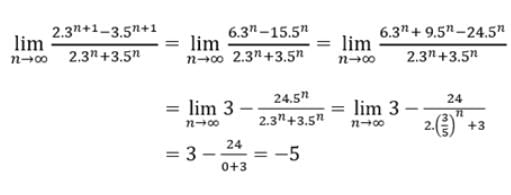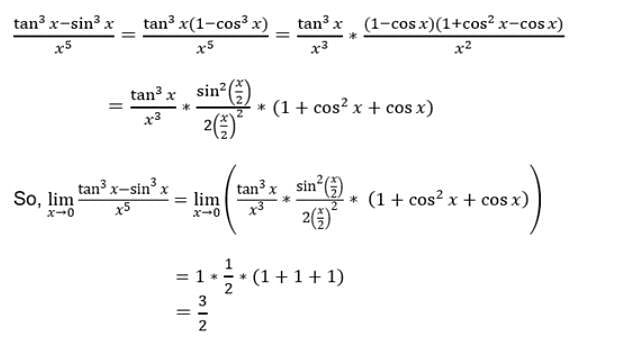JEE Exam > JEE Tests > Chapter-wise Tests for JEE Main & Advanced > JEE Advanced Level Test: Limit & Derivatives- 2 - JEE MCQ
JEE Advanced Level Test: Limit & Derivatives- 2 - JEE MCQ
Test Description
30 Questions MCQ Test Chapter-wise Tests for JEE Main & Advanced - JEE Advanced Level Test: Limit & Derivatives- 2
JEE Advanced Level Test: Limit & Derivatives- 2 for JEE 2024 is part of Chapter-wise Tests for JEE Main & Advanced preparation. The JEE Advanced Level Test: Limit & Derivatives- 2 questions and answers have been
prepared according to the JEE exam syllabus.The JEE Advanced Level Test: Limit & Derivatives- 2 MCQs are made for JEE 2024 Exam. Find important
definitions, questions, notes, meanings, examples, exercises, MCQs and online tests for JEE Advanced Level Test: Limit & Derivatives- 2 below.
Solutions of JEE Advanced Level Test: Limit & Derivatives- 2 questions in English are available as part of our Chapter-wise Tests for JEE Main & Advanced for JEE & JEE Advanced Level Test: Limit & Derivatives- 2 solutions in
Hindi for Chapter-wise Tests for JEE Main & Advanced course. Download more important topics, notes, lectures and mock
test series for JEE Exam by signing up for free. Attempt JEE Advanced Level Test: Limit & Derivatives- 2 | 30 questions in 60 minutes | Mock test for JEE preparation | Free important questions MCQ to study Chapter-wise Tests for JEE Main & Advanced for JEE Exam | Download free PDF with solutions
Detailed Solution for JEE Advanced Level Test: Limit & Derivatives- 2 - Question 1
Detailed Solution for JEE Advanced Level Test: Limit & Derivatives- 2 - Question 2
| 1 Crore+ students have signed up on EduRev. Have you? Download the App |
Detailed Solution for JEE Advanced Level Test: Limit & Derivatives- 2 - Question 3
Detailed Solution for JEE Advanced Level Test: Limit & Derivatives- 2 - Question 4
Detailed Solution for JEE Advanced Level Test: Limit & Derivatives- 2 - Question 5
Detailed Solution for JEE Advanced Level Test: Limit & Derivatives- 2 - Question 6
Detailed Solution for JEE Advanced Level Test: Limit & Derivatives- 2 - Question 7
Detailed Solution for JEE Advanced Level Test: Limit & Derivatives- 2 - Question 8
Detailed Solution for JEE Advanced Level Test: Limit & Derivatives- 2 - Question 9
Detailed Solution for JEE Advanced Level Test: Limit & Derivatives- 2 - Question 10
Detailed Solution for JEE Advanced Level Test: Limit & Derivatives- 2 - Question 11
Detailed Solution for JEE Advanced Level Test: Limit & Derivatives- 2 - Question 12
Detailed Solution for JEE Advanced Level Test: Limit & Derivatives- 2 - Question 13
Detailed Solution for JEE Advanced Level Test: Limit & Derivatives- 2 - Question 14
Detailed Solution for JEE Advanced Level Test: Limit & Derivatives- 2 - Question 15
Detailed Solution for JEE Advanced Level Test: Limit & Derivatives- 2 - Question 16
Detailed Solution for JEE Advanced Level Test: Limit & Derivatives- 2 - Question 17
Detailed Solution for JEE Advanced Level Test: Limit & Derivatives- 2 - Question 18
Detailed Solution for JEE Advanced Level Test: Limit & Derivatives- 2 - Question 19
JEE Advanced Level Test: Limit & Derivatives- 2 - Question 20
If [x] denotes the greatest integer less than or equal to x then
Detailed Solution for JEE Advanced Level Test: Limit & Derivatives- 2 - Question 20
JEE Advanced Level Test: Limit & Derivatives- 2 - Question 21
Let f : R → R be a positive increasing function with 
Detailed Solution for JEE Advanced Level Test: Limit & Derivatives- 2 - Question 21
Detailed Solution for JEE Advanced Level Test: Limit & Derivatives- 2 - Question 22
Detailed Solution for JEE Advanced Level Test: Limit & Derivatives- 2 - Question 23
Detailed Solution for JEE Advanced Level Test: Limit & Derivatives- 2 - Question 24
Detailed Solution for JEE Advanced Level Test: Limit & Derivatives- 2 - Question 25
Detailed Solution for JEE Advanced Level Test: Limit & Derivatives- 2 - Question 26
Detailed Solution for JEE Advanced Level Test: Limit & Derivatives- 2 - Question 27
Detailed Solution for JEE Advanced Level Test: Limit & Derivatives- 2 - Question 28
Detailed Solution for JEE Advanced Level Test: Limit & Derivatives- 2 - Question 29
Detailed Solution for JEE Advanced Level Test: Limit & Derivatives- 2 - Question 30
|
446 docs|930 tests
|
Information about JEE Advanced Level Test: Limit & Derivatives- 2 Page
In this test you can find the Exam questions for JEE Advanced Level Test: Limit & Derivatives- 2 solved & explained in the simplest way possible.
Besides giving Questions and answers for JEE Advanced Level Test: Limit & Derivatives- 2, EduRev gives you an ample number of Online tests for practice
|
446 docs|930 tests
|
Download as PDF


 (k is a positive integer)
(k is a positive integer)

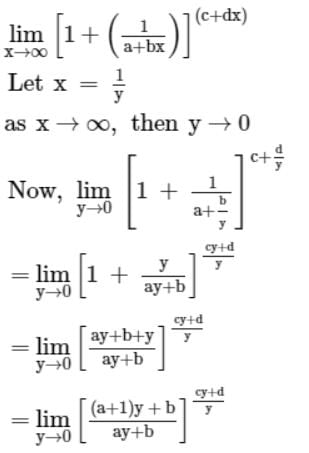
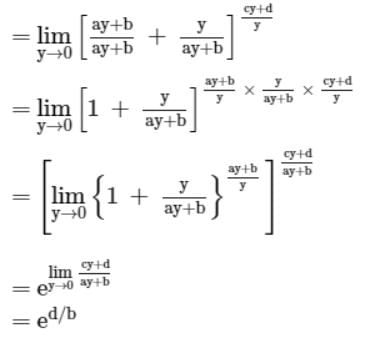








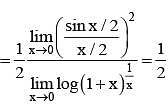



 = e2 then
= e2 then


